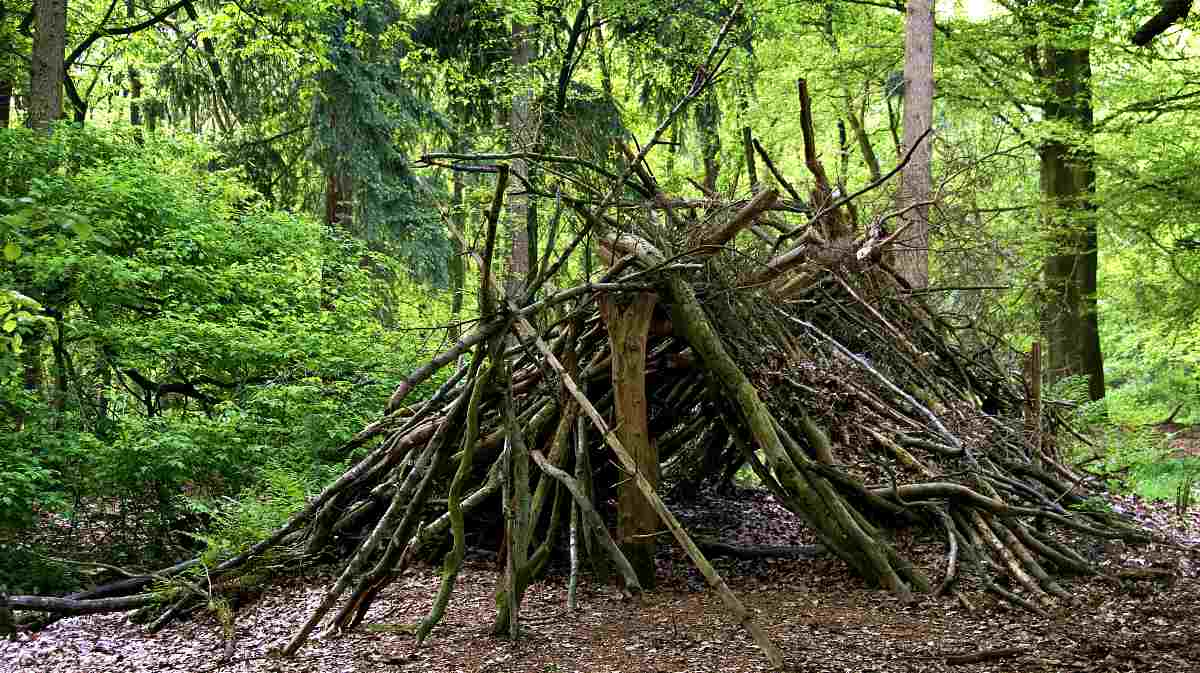Preparedness
8 Steps To Survive Anything

You’ll never know when disaster will strike, so check out these steps to survive anything and prepare yourself for every eventuality.
RELATED: 25 Obscure Bushcraft Skills For Survival
In this article:
Steps to Survive Anything | Basic Survival Knowledge
While in the U.S. Air Force
As a young Airman teaching students at the U.S. Air Force Survival School, I was posed a riddle by one of my officer students. He said to me, “Imagine you are lost in the woods, it’s freezing cold, hypothermia is setting in, and you come across a cabin in the middle of nowhere.
You enter the cabin and there is a lantern, fully functional and ready to go. There is also a wood-burning stove and a stone fireplace with paper and kindling.
What do you light first?”
I replied, “I would light the fireplace.” A large smile spread across his space and he said, “Nope, you light the match first!”
Then it was my turn to smile and reply, “But sir, we don’t use matches!” And I also reiterated that as an Air Force survival instructor, we never became lost.
It was refreshing to see the lieutenant was thinking about survival matters and possible scenarios one might encounter.
Over the course of nearly two decades, I encountered many people who had never camped nor hiked. They also didn’t know the first thing about the basics in the survival book.
As a professional instructor, I’m proud to see those same people leave with the confidence to survive on the basic skills they had learned. The majority of the students who go through the Air Force survival school must have this knowledge to accomplish their mission and continue in their chosen field.
This article will be a short introduction to the basics of survival that can save your life.
1. Increase Your Will to Survive

First and foremost is the Will to Survive, W2S. You can have nearly every tool at your disposal and perish because you gave up, or you can have next to nothing and refuse to die through sheer force of will.
As the old adage says, “You can survive three weeks without food, three days without water, three minutes without air, but not three seconds without hope!”
Nearly everyone has heard tales of incredulous ordeals endured only by the will to survive. Various movies have been made about such topics, such as the soccer team stuck in the Andes or Shackelton’s voyage to the Antarctic.
The will to survive is something everyone is born with; however, it is an attribute one can bolster even more.
The mental desire and discipline to live can be hardened to the point where giving up is not an option. Learning new skills, new techniques, and acquiring knowledge are a few ways to help yourself and those you love.
W2S is vital to stay alive and to get out of a bad situation intact, just as vital as having a plan to help you accomplish that goal.
2. Take a Minute and STOP
Your mindset and willingness to endure hardships will be the basic keys on how to survive anything anywhere in the world and in any condition.
The will is equally as important as knowledge, equipment, and skills. And you obtain all of these through study and practice.
Though it seems counterproductive in a survival situation, one of the first things you must do is S.T.O.P.
- Stop! – Literally, stop. Take two seconds to grasp your situation, check yourself medically. Check your body because if adrenaline is pumping, you may have been injured without realizing it. Then, check your inventory and get ready for what is to come. Mentally and physically ensure you are ready for the ordeal in store.
- Think – Consider your body, mind, equipment, environment, and location in that environment. Look for potential communication and signaling possibilities. How likely is a rescue to arrive and how soon? Weigh your situation and then…
- Organize – Your gear, your body, whatever you have to help improve your situation or whatever you can scrounge from the vehicle, the aircraft or the environment you are in. Take anything you can find because you never know what use you will have for it. Too often, survivors have left behind valuable equipment because they did not want the few extra pounds of weight or because they did not think they would need that particular item.
- Plan – Prioritize your needs based on necessity and prepare your next move. Keep in mind that your plan must be flexible in such a turbulent situation, and it is subject to change. Instead of exerting energy blindly or moving in a random direction, plan what you are going to do next and how you are going to do it. Having a plan will greatly help you to achieve the ultimate goal of returning home.
3. Acquire Basic Medical Knowledge
The next basic facet of survival is medical. Whether it be professional medical knowledge, first-aid know-how, or a medical survival guide, you must know how to deal with physical emergencies as they arise.
Not only should you consider medical procedures to be a reflexive attribute, such as when a cut, scrape or break occurs, but it should also be a proactive attribute.
For instance, in a colder environment, you must ensure you aren’t succumbing to frostbite. Or in a desert environment, you aren’t dehydrating and becoming afflicted with heat exhaustion or heat stroke.
In a tropical environment, this includes using some type of insect repellent or mud if there are no other options. At times you may have to get creative and use what is in the environment.
Local plants are some of the best remedies if you know which ones are edible and how to use them. The best medical treatment is prevention!
4. Ensure Appropriate Clothing for the Situation
If you find yourself suddenly thrust into a survival situation with literally only the clothes on your back, clothing will become vital. In those moments, even something as simple as a pair of gloves or an extra pair of socks could be crucial.
I will delve more into personal survival kits (PSK’s) in the future but consider what you carry on your body on a day-to-day basis and assess your survival chances if you were stranded this moment.
In 2005, I was deployed to Djibouti, Africa at Camp Lemonier. I used to carry a large Camelbak with me as well as various items inside the bag that made up my personal survival kit.
One day a Marine officer jokingly asked me if I went to the bathroom with that thing on, I said, “Yes I do sir.”
I went on to explain that if we had an alert for incoming threats, there would be no time to run back to my office, grab the bag, and get to a bunker. I knew that with what I had inside that bag, I would survive for at least two days before my water ran out.
RELATED: Top Survival Skills | Learn Now, Survive Later
5. Find Shelter Immediately

When it comes to shelter there are two types: immediate action and long-term. An immediate action shelter can be anything that aids in protecting you from the elements in a short time frame.
Examples are caves, tree wells, rock overhangs, etc.
A short-term shelter can also be something you can make or improve upon but something that takes a small amount of time. A long-term shelter is something man-made or something that needs a large amount of improvement.
These shelters are generally types that take more than 30 minutes to construct. Perfect examples are teepees, log cabins, snow caves, igloos, etc.
6. Know How to Build and Maintain a Fire
The old “Survival TV” is a universal favorite from 2-year-olds to 102-year-olds. Everyone has fond memories of sitting around a fire.
Maybe you were relaxing, making s’mores, telling ghost stories, having a beer, or merely enjoying spending time with friends and family.
In modern society, the ability to start a fire has become amazingly simplified. When people are thrust into a situation where matches, lighters, newspaper, and lighter fluid are not readily available, it becomes a huge challenge.
As much as fire craft is a physically protective facet, it is also an important psychological factor in survival.
7. Attempt Contact with Civilization
Lastly, consider signaling and communication, because either of those things may be your ticket home.
In a separate article, I will discuss navigation because “self-rescue” may be the only option depending on the situation. However, a cell phone, radio, or emergency beacon can greatly aid you in getting out of a sticky situation.
If none of those is available, then being able to construct a signal with natural materials or flares may get you rescued. Classic examples include an SOS message stamped in the snow or help created from logs.
A flag made of cloth attracts attention due to the movement. A signal mirror is invaluable, especially out on the ocean when potential rescue vehicles are miles away.
There are many pieces of equipment you can use and many things you can improvise. These signaling and communication items should help you return home, which is the number one goal in any survival situation.
8. Find Sustenance for Long-term Survival
I saved sustenance for last because, in my general opinion, if you enter a situation in a relatively normal and healthy state, sustenance can be put on hold for a while. It will most definitely become a vital part of survival, but if you have even a small water bottle, then you can worry about water and food later after more pressing concerns.
With all that said, water and food are the key components of sustenance and both are vital to survival.
Water is, of course, necessary to all life. We need water to survive and to maintain our bodies at a stable 98.6 degrees.
This is true especially if we are injured or under extreme duress or exertion from intense circumstances.
In a survival situation, plain water is the best liquid to ingest. Nothing else will substitute for plain, good old-fashioned, H2O.
Unfortunately, due to our ability to procure food immediately from the grocery store, obtaining filling food in the wild will undoubtedly be a challenge. One of the most difficult things to overcome will be food aversions, such as snacking on bugs or wild animals you don’t usually eat.
If plants are the plentiful foodstuffs, there is the danger of eating poisonous or harmful plants.
There are great “universal” plants that anyone can identify and that are usually found anywhere around the world, hence the term universal. Some classic examples are Cattail, Dandelion, and Bamboo.
Watch this video by Sikana English about a family emergency preparedness plan:
Hopefully, you now have a broader understanding of how to make it out of survival situations alive. These are key components to help you survive any situation, regardless of where you find yourself.
I hope this short introduction has jump-started your journey towards preparation.
Take the first step to becoming a survival guru today! Do you know any more survival tips and tricks? Please share with us in the comments section below!
UP NEXT:
- 17 Old School Survival Skills You Should Know
- 15 Urban Survival Skills That Could Save Your Life
- How To Purify Water | 5 Water Decontamination Techniques
Editor’s Note: This post was originally published in February 2018 and has been updated for quality and relevancy.
-

 Do It Yourself7 months ago
Do It Yourself7 months agoParacord Projects | 36 Cool Paracord Ideas For Your Paracord Survival Projects
-

 Do It Yourself10 months ago
Do It Yourself10 months agoHow To Make Paracord Survival Bracelets | DIY Survival Prepping
-

 Do It Yourself9 months ago
Do It Yourself9 months ago21 Home Remedies For Toothache Pain Relief
-

 Do It Yourself10 months ago
Do It Yourself10 months agoSurvival DIY: How To Melt Aluminum Cans For Casting
-

 Exports8 months ago
Exports8 months agoAre Switchblades Legal? Knife Laws By State


Ralston Heath
February 14, 2018 at 1:49 PM
A good article that gets you started in the world of “prepping”. To always be ready, and part of that is knowledge and will. Good stuff and looking forward to seeing more. Thanks
Pingback: Survival Life - Survive!
Clergylady
March 12, 2018 at 7:56 AM
Learning skills, practicing them, and thinking about how to apply them all work together.
Encouraging people to make that knowledge theirs may save lives.
Reading about a skill doesn’t make it useable untill you practice it enough to be confident in doing it. Practice, practice, practice, then do it some more. I did that with my children as they grew up. Each one learned to gather fire materials and make a sucessful fire started in atleast 3 and preferably more ways. By age ten each one had mastered that minimum knowledge. Then they learned to bank a fire, move hot coals to start more fire in a new place, and how to kill and cover the evidence of a fire. Tracking, marking a trail, covering a trail, identifying foods and medicinals local to where they were, were all required. My mother had taught me without saying it. It was just something we did so it came easy and natural. We camped and traveled as a family with more knowledge than supplies. Dad taught me to be resourceful and improvise. Those skills can apply in many ways to all of your life. But a love of nature and a willingness to try new things can add to the ease and adjustment to life as it comes.
I enjoy the articals. They present a mindset even more important than many of the skills you need to learn.
Jim
March 16, 2018 at 7:32 AM
very well said-
Anonymous
October 31, 2018 at 10:20 AM
what that mean can you make a fire with only stick ya no that what I thought also be a good person and reply
Jim
March 16, 2018 at 7:31 AM
I taught my children from the time they were old enough to walk around-PANIC KILLS. If you can keep calm and think about your situation, regardless of how bleak it initially looks, your chances of getting through it just doubled without you lifting a finger yet. Mental preparedness and that never say die-never surrender attitude can overcome a lot of obstacles. Then you take stock of what you have versus what you are facing and plan your strategy and response. We like to think it is a safe and comfortable world out there, but in reality once you roll off your couch and out your door, just about anything can happen and usually does. Good luck-stay safe.
Jeanne Leger
March 16, 2018 at 1:19 PM
All, very good info. I always taught “Assess, assess, assess” the situation, think and look around to see what can be used, but above all, don’t panic! More lives are lost through panic than anything else.
Jeanne Leger
March 16, 2018 at 1:23 PM
I also should have stated, make a PLAN, after you have rested and taken care of any emergency medical care, think it through, review the plan, amend if necessary, and then FOLLOW THE PLAN to the letter!
Pingback: 8 Steps to Survive Anything | Life Off The Grid
Pingback: How To Survive Sleep Deprivation | Survival Life
Pingback: Surviving Sleep Deprivation | Primitive technology
Pingback: Surviving Sleep Deprivation
Pingback: 18 Items To Stockpile For Emergencies | Primitive technology
Pingback: 18 Items To Stockpile For Emergencies - Survive!
Pingback: 18 Items To Stockpile For Emergencies
Pingback: Benefits of Dandelions | More Reasons to Love the Survival "Weed"
Pingback: Things You Need to Live Off the Grid | Survival Life
Pingback: 9 Things You Need To Live Off The Grid – Ultimate Survival Alerts
Pingback: Rule of Threes: The Basic Guide To Survival | Survival Life
Pingback: 8 Steps To Survive Anything - Survival Gear Review